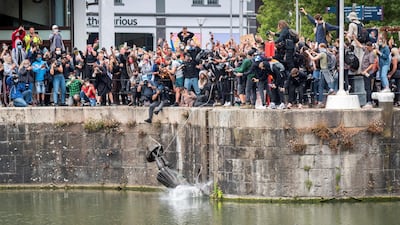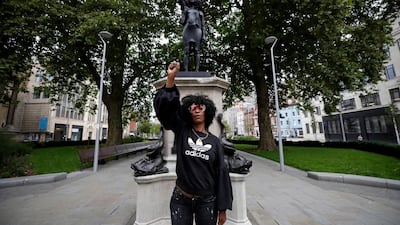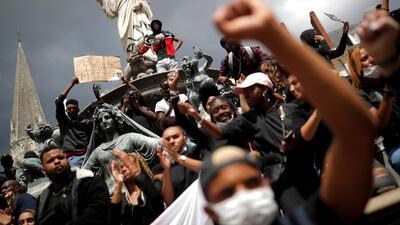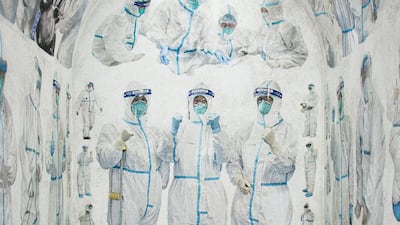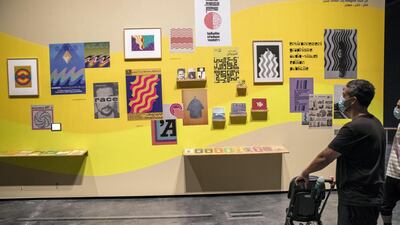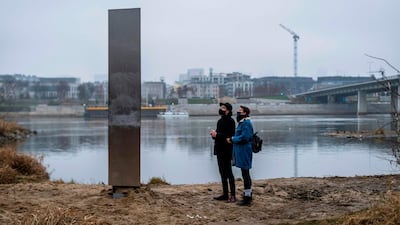It has been a challenging year for the arts. Despite the migration of events to the digital realm, artists and art spaces have grappled with financial downturns, while institutions have been pushed to confront their legacies of violence and exclusion.
As 2020 comes to close, here are the biggest moments in the art world, the effects of which will continue to shape how we experience, think about or talk about art in the year to come.
Closed and cancelled
It started with Art Basel Hong Kong, the first major art fair to be cancelled as the coronavirus made its way around the world. The Asian edition of the mammoth international art event was called off in February, ahead of its March schedule. Others soon followed suit – in the UAE, Art Dubai eventually adapted to a virtual fair, while Sharjah Art Foundation's March Meeting was postponed, with new 2021 dates only recently announced. Big fairs such as Frieze in New York and Art Basel in Switzerland and Miami also moved to the digital world.
Alongside the cancellations were the closures, from the Met and the Museum of Modern Art in New York to the Tate galleries, Victoria and Albert Museum and British Museum in the UK. Museums in Europe and the UK have since gone into on-and-off closures as the second wave of the virus struck in the autumn months.
In the UAE, Louvre Abu Dhabi, Jameel Arts Centre, Sharjah Art Museum and Alserkal Avenue's galleries were shuttered in March too. Cultural spaces began to reopen in May and June, and are now welcoming guests in limited capacities.
Going virtual
With spaces closed and international travel restrictions in place, arts and culture migrated to the digital realm. The internet was awash with virtual exhibitions and art fairs, online workshops and symposia, in many ways making us more connected than before. Notable virtual events included the Metropolitan Opera streaming performances from its archives for free, while the British Museum offered a virtual walk-through of its space.
The art of the online challenge
Online challenges caught on in the arts, such as the widespread Getty Museum Challenge, which asked the public to recreate famous artworks at home. Submissions came pouring in, with household items and pets creatively transformed into props or subjects.
There was also the #CuratorBattle by the Yorkshire Museum in the UK, which asked other institutions to show off their collections under themes such as "creepiest object" and "sassiest object".
Impact of Black Lives Matter
Conversations around race and systemic discrimination in the art world came to the fore in the wake of George Floyd's murder in May. While protests were filling the streets, the debate around monuments in the West and Confederate statues in the US raged – are they key historical reminders or do they glorify former oppressors?
In Bristol, protesters toppled the statue of slave trader Edward Colston in June, while statues of Thomas Jefferson and Christopher Columbus were also taken down in US cities.
Most recently, a statue of Robert E Lee, a confederate general, was removed from the US Capitol. It will be replaced by one of Barbara Johns, a civil rights leader who led a student strike for equal rights in 1951.
Museums were quick to try to respond to the moment, though not always successfully. In the case of the Whitney Museum of American Art, controversy erupted after the announcement that a show, meant to reflect on the Black Lives Matter movement, would be filled with Black artists' works that were bought from a fundraising initiative. The artists spoke out against what they described as a "predatory" acquisition process, and the exhibition was cancelled.
Museums and money
Amid deepening economic crises, museums and galleries are also feeling the pinch; Unesco has stated that one in eight museums worldwide may be forced to close down due to the pandemic. Many other institutions have been finding ways to stay afloat by deaccessioning their collections or laying off staff.
Both moves have been criticised, the latter especially so. Despite its $3 billion endowment, the Metropolitan Museum of Art has cut 20 per cent of its staff since March as it projects a $150 million loss of revenue due the pandemic.
There have also been mass redundancies in UK institutions: the Tate initially cut 295 jobs from its commercial workforce before announcing it will slash 120 more from its gallery staff; Southbank Centre in London warned of 400 redundancies in June, though it has since rehired a small number this month; and the Royal Academy of Arts plans to cut 40 per cent of its staff. The layoffs have prompted protests in London.
Frustrations around working conditions and diversity combined with the cultural shift spurred by Black Lives Matter have also given rise to anonymous social media accounts that call out unfair practices in the art world.
Accounts such as Change the Museum and Cancel Art Galleries feature stories from former employees exposing racism and abusive behaviour at museums and galleries primarily in the US.
Rise of bailouts and fundraising efforts
These financial losses have compelled public and private players to step up efforts to help, including a $54 billion package from the German federal government for the country’s creative and cultural sectors.
In the region, private entities such as Jameel Arts Centre have announced grants for artists, while Alserkal Avenue waived rent for its cultural tenants for three months.
The UAE also launched the National Creative Relief Programme, offering freelancers and small businesses in the creative field a chance to apply to grants. As of August, the scheme has provided Dh4.6 million in grants to the country's creative sector.
Beirut blast shatters art scene
The devastating Beirut blast in August left the Lebanese capital’s art scene in tatters, with galleries, museums and heritage sites among those heavily damaged. Lebanon’s Ministry of Culture found that at least 8,000 buildings were affected by the explosion, including 640 historic buildings.
In August, Unesco, Louvre Museum in Paris and other international organisations have pledged a "cultural first aid" for Beirut to help restore damaged libraries, historic buildings and museums. Across the region, fundraising efforts by artists and organisations have also contributed to charities and art spaces in Beirut.
Wave of pandemic art
Medical masks have become the symbol of the Covid-19 crisis and ubiquitous in pandemic art. Since March, artists around the world have been responding to this moment in various ways, from tributes to medical workers to visual reminders of solidarity in the face of uncertainty and fear.
Pandemic art had its moment in the spotlight, with the creation of the Covid Art Museum, Banksy's parachuting rats in London and sneezing woman in Bristol, Disney characters practicing social distancing, and many more.
Strides in restitution
In October, activist Emery Mwazulu Diyabanza attempted to take a sculpture from the Louvre in Paris. It was part of a campaign by a pan-African group Unite Dignite Courage, which calls for the restitution of African heritage and artefacts. This incident is part of a larger movement calling for the repatriation of looted objects from European institutions to their countries of origin.
Last month, the French Senate had signed a bill that promises to return 26 sculptures from the Quai Branly Museum to Benin and a sword back to Senegal. In Nigeria, an institution intends to build a new museum over the next four years that could exhibit looted Benin Bronzes currently displayed in European and American museums.
French President Emmanuel Macron has been a supporter of repatriation, tweeting in 2017, “African cultural heritage can no longer remain a prisoner of European museum.” A 2018 report that he commissioned revealed that around 90,000 African works are currently held in French collections, with few ever returned.
In Nigeria, architect David Adjaye is designing a museum meant to house the Benin Bronzes, currently on display at the British Museum and the Ethnological Museum of Berlin. These 1,000 prized metal plaques and sculptures were looted by British troops from the royal palace of the Kingdom of Benin in 1897.
Monolith as meme
Monoliths are cropping up around the world, thanks to a mysterious object that was first discovered in Utah in November. The shiny metal pillar was spotted by a local wildlife agency after a routine inspection of the area via helicopter. When news of the monolith became public, curious individuals began to make their way to the desert to see the object in person.
Less than two weeks later, the monolith was anonymously taken down and copycats began springing up in more US cities, as well as Romania, Sweden, the UK, Germany, New Zealand.
The origins of the first monolith remain unknown, though some have put forward names of artists who may have installed the work as a kind of creative intervention. How or why it has become a global phenomenon is possibly just as strange, though perhaps it is the mystery that keeps it going.
